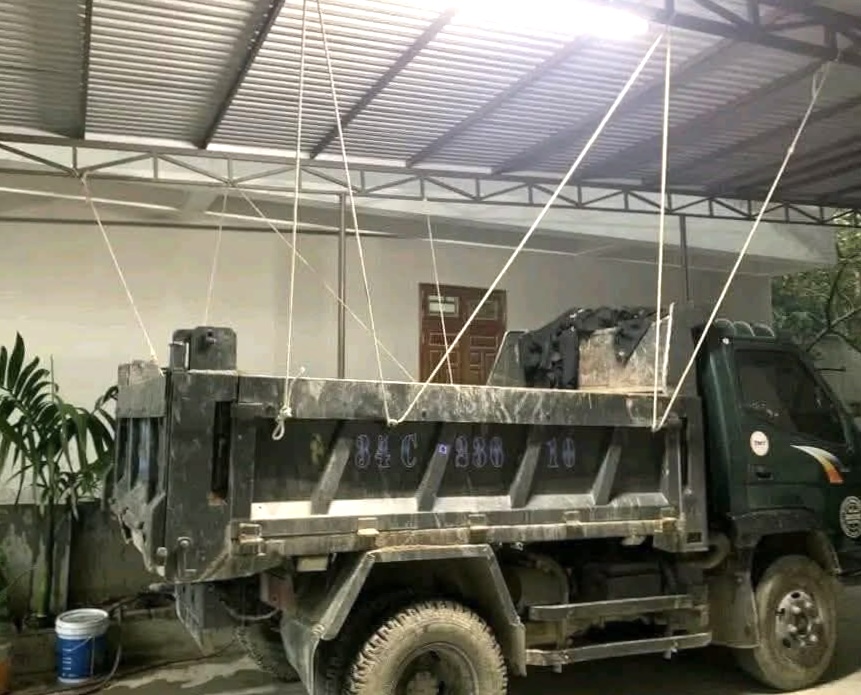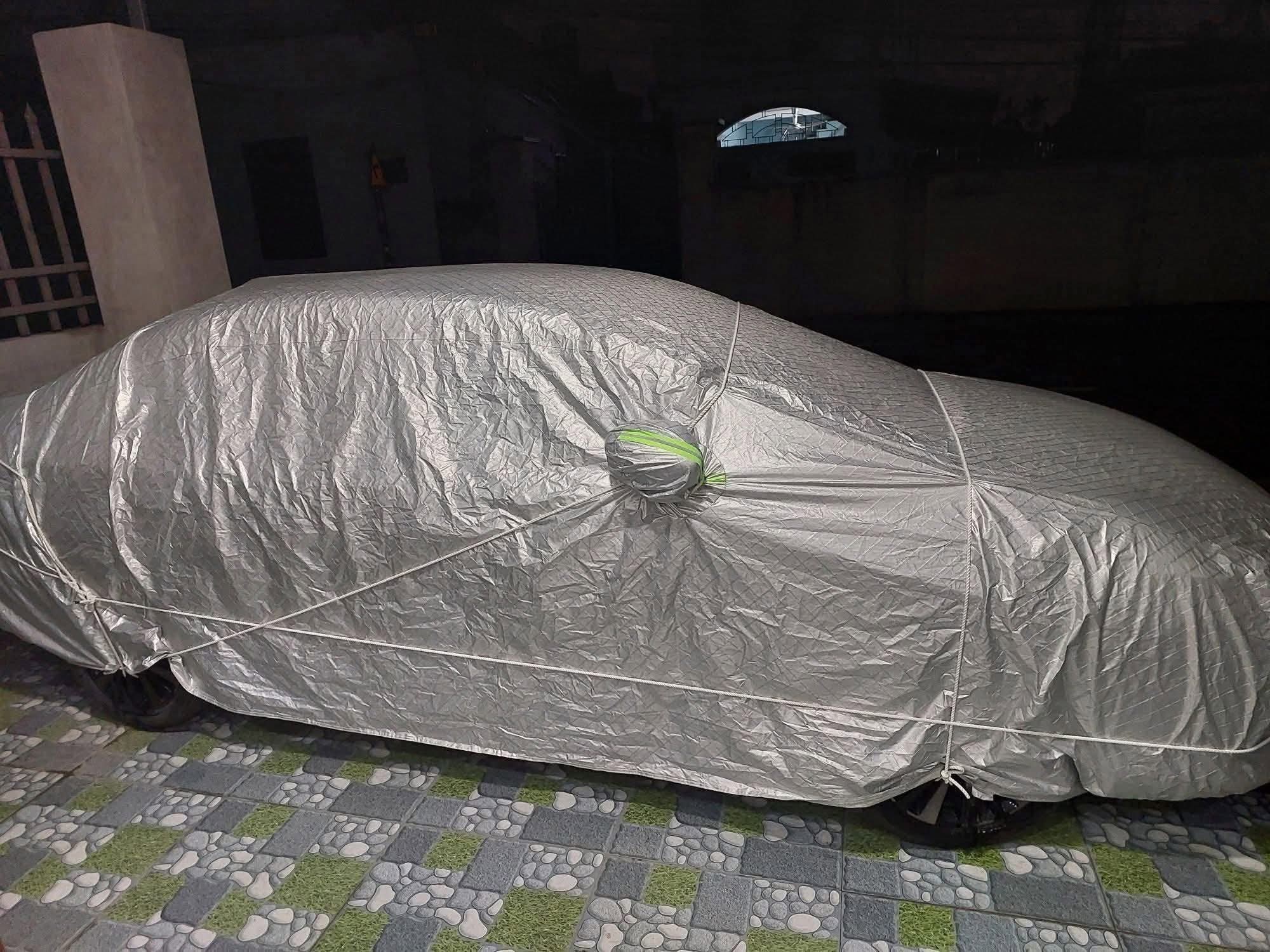In Hai Phong, Binh An, a resident of Viet Hoa ward, began reinforcing the roof around his house on the afternoon of 20/7 as soon as news of the approaching typhoon broke.
He parked his multi-ton truck in the middle of the yard and used large ropes to secure the metal roof frame to the truck, effectively turning the vehicle into a sturdy anchor. He hoped this would protect his newly installed roof.
An explained that this method of adding weight and stability to the roof structure was a lesson learned from Typhoon Yagi in 9/2023. Last year, without these precautions, his entire roof was torn off and lost, costing tens of millions of dong to replace. This time, he meticulously wrote his name and phone number on each sheet of metal to aid in recovery if they were to blow away.
"Having learned that hard lesson, I had to reinforce my roof early this year, hoping to prevent it from being blown away again," An said.
 |
Binh An uses ropes to secure his truck to the roof of his house in Viet Hoa ward, Hai Phong City on 20/7, hoping to prevent it from being blown away during the typhoon. Photo: Binh An |
Binh An uses ropes to secure his truck to the roof of his house in Viet Hoa ward, Hai Phong City on 20/7, hoping to prevent it from being blown away during the typhoon. Photo: Binh An
The memory of the nearly 500 million dong spent repairing their auto repair shop after Typhoon Yagi last year prompted Nguyen Thi Ha and her husband in Thanh Mien commune, Hai Phong City, to take early precautions.
According to Ha, their garage is located on a national highway, a wide-open and wind-prone location. Last year, believing Typhoon Yagi would weaken upon landfall, they only closed the shop without any additional reinforcement.
"But the devastation the next day left me speechless," Ha recalled.
The wind tore down the entire 500 m2 roof and signboard, ripping apart the surrounding metal walls. Rainwater poured in, severely damaging machinery and equipment. The total damage of nearly 500 million dong left the family financially drained.
This year, the couple mobilized workers to remove the signboard early. After researching roof-securing tips online, they placed dozens of heavy truck tires and old containers on the roof on the morning of 20/7. They also interspersed the tires with thick nylon bags filled with water to add weight and create a secure system across the entire 500 m2 roof. All cars under repair in the garage were also rushed to completion on the afternoon of 21/7, to be handed over to customers before the typhoon hit. Before closing the shop, they also purchased large iron bars and wood to barricade the doors against the wind.
"Before implementing these measures, we checked the weight of each tire to ensure they wouldn't be blown away by the typhoon," Ha said.
Workers at Ha's auto repair shop transport tires to the roof before placing them along with large water-filled nylon bags to prevent the roof from being blown away, morning of 20/7. Source: @HaKhang8386
In Bai Chay, Quang Ninh province, 33-year-old Xuan Thang opted not to use water-filled nylon bags or sandbags on his roof. Instead, he secured two long iron bars lengthwise along the roof with screws, clamping the metal sheets in between. Finally, he threaded a cable through the ends of the iron bars, tensioning it with a turnbuckle and anchoring it to the ground.
Thang believed that while using sandbags or water bags to weigh down roofs is common, it carries risks. Strong winds could dislodge the bags, posing a danger if they fall onto the street or if the water bags burst. Therefore, he chose a safer solution by clamping the roof from both above and below with iron bars.
"This method is effective, costs only a few hundred thousand dong, and saves the effort of preparation every time there's a typhoon," he said.
Xuan Thang in Quang Ninh shares his tip for securing a roof without using water-filled nylon bags or sandbags. Source: @autoxuanthang
Social media groups are buzzing with shared experiences and advice on typhoon preparation. Tips range from taping windows, placing sandbags or water bags on roofs, to wrapping cars in tarpaulins and adding foam padding for impact protection. Many commenters have adopted these methods, hoping to minimize damage from the impending storm.
Nguyen Duyen's family, in Kien Minh commune, Hai Phong City, is no exception. She brought all hanging flower baskets indoors. Larger potted plants that couldn't be moved were laid down on the ground to reduce wind resistance. For their car, they not only covered it with a tarp but also added thick foam padding around the body to protect it from flying debris.
"We've done everything we can. An ounce of prevention is worth a pound of cure. We hope the typhoon will weaken before making landfall," Duyen said.
 |
Nguyen Duyen and her husband in Hai Phong City cover their car on the evening of 20/7, before adding thick foam padding around the body the next morning. Photo: Nguyen Duyen |
Nguyen Duyen and her husband in Hai Phong City cover their car on the evening of 20/7, before adding thick foam padding around the body the next morning. Photo: Nguyen Duyen
According to the National Center for Hydro-Meteorological Forecasting, at 7 a.m. on 21/7, the center of Typhoon Wipha, the third typhoon of the season, was located approximately 220 km east of Quang Ninh - Hai Phong. Maximum sustained winds reached level 9 (75-88 km/h), with gusts up to level 11. The typhoon is moving west-southwest at a speed of 15-20 km/h.
From the night of 21/7, coastal areas from Quang Ninh to Nghe An will experience strong winds of level 7-9, while areas near the typhoon's center will face level 10-11 winds, with gusts up to level 14.
From 21/7 to 23/7, the Northeast, the Red River Delta, Thanh Hoa, and Nghe An are forecast to receive widespread rainfall of 200-350 mm, with some areas exceeding 600 mm, posing a high risk of flash floods, landslides, and inundation.
Quynh Nguyen












